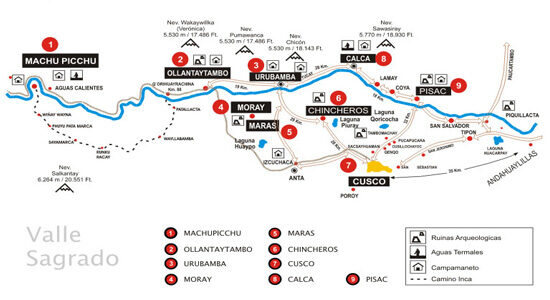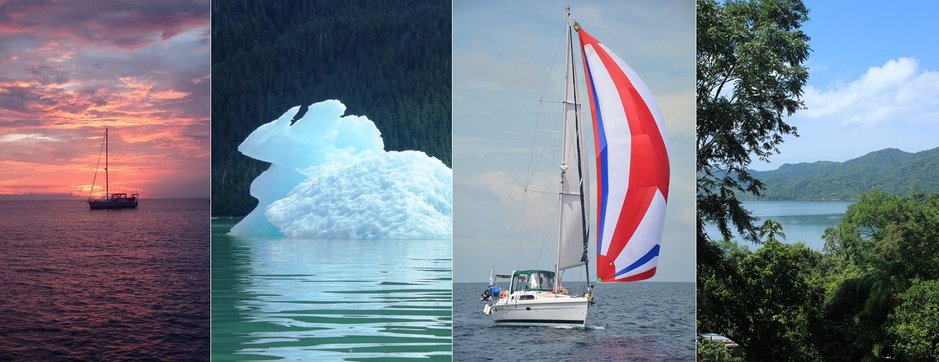When we tried to research how to get to Machu Picchu we ran into lots of conflicting information. Some was old, some was just plain confusing. So we are documenting what we learned in the hopes of it helping someone else make the trip. I’ve not included any info here about the 4 day hike along the Inca Trail because we didn’t do that. So this is the guide for those of you looking for the less strenuous way to get there.
Here is a map of the area around Machu Picchu, Cusco, and surrounding areas that shows the locations of local ruins. Turns out there is a lot more to do in the area than was obvious from our research. One of the mistakes we made was in not planning enough time in the area to see more of the Inca ruins and other sights in towns like Ollantaytambo, Pisac, and Urubamba. In many of these towns the original Inca foundations of the houses are still being used by families living there today. Touring the towns and their local Inca ruins can add color to your trip.

When to Go
The high season is June to August. During these months you are assured the best weather. However, this is when the crowds will be at their worst. They let 4,000 visitors a day visit the site during these months. Hotel prices are higher during these months and probably restaurant prices go up too. October and April/May are generally still good weather, but generally there are less visitors so its slightly less crazed, and hotels are cheaper. Also, in April/May the site will be greener due the rainy season having just passed.
Getting There
The airport you need to get to is Cusco (airport code CUZ). You will probably have to fly through Lima (capital of Peru) to get there. We were able to use our Alaska miles to get from Seattle to Lima and then paid for the flight to Cusco. Rumor has it they are working on a new international airport for Cusco that might mean you can get there without going through Lima someday.
Once in Cusco you have to take the train to the town of Aguas Calientes which is at the base of Machu Picchu. It’s a town that exists solely to service the 2 Million visitors a year to Machu Picchu. There are two places you can catch the train in Cusco or in Ollantaytambo. The Cusco train station is actually in the small town of Poroy just outside Cusco. You may read articles that you shouldn’t take the train from Cusco because of bad tracks, closures, etc, but this is old information. As of this writing the train from Cusco is a fine option, though there are only 4 trains per day from Cusco, whereas there are about twice that number departing from Ollantaytambo. Departing from Cusco is also a bit more expensive than Ollantaytambo, so if you want to save a few dollars you can take a bus from Cusco to Ollantaytambo and catch the train there. We decided that we wanted to stay around Cusco and Ollantaytambo to see the sights before and after our Machu Picchu visit, so it made sense for us to catch the train in Ollantaytambo.
Note that unless you are walking the Inca Trail, the train is your only option. There are no cars in Aguas Calientes because there are no roads to the town. The buses used to take you to the Machu Picchu site from town were brought in via rail car.
There are two train companies (Inca Rail and Peru Rail) and a variety of options. The chart below shows the different classes of travel and sample pricing that was current as of the time of this publication. Pricing does vary by time of day, and presumably also goes up in the high season. Prices are shown round trip, but can also be purchased one way. So if you wanted to splurge on the famous Hiram Bingham train one way and take the cheaper options on the return you can certainly do that.

Here is another great article that has current information on how to get to Machu Picchu: http://agringoslifeincusco.wordpress.com/2014/07/22/machu-picchu-how-to-get-there/
Where to Stay
There is one hotel that is right outside the entrance to Machu Picchu – Belmond. This hotel is crazy expensive (rates start at $1400 per night), but it’s right there at the site. There are lots of other options in Aguas Calientes. TripAdvisor or any other hotel travel site can help you choose which one is right for you. We stayed at Terrazas del Inca for only $70 per night.
We stayed at a great B&B just outside Cusco – Gringo Wasi for $50 per night. It’s run by an American and his Peruvian wife. They were great resource about tours near Cusco and the surrounding area, and their place is a good central location from which to see those sites.
Getting from Aguas Calientes to the Machu Picchu Site
From Aguas Calientes you need to take the bus up the switchback road to the entrance to Machu Picchu. Assuming you are arriving in Aguas Calientes the night prior to your all day visit to the Machu Picchu site, go the night you arrive to buy your tickets. Buses run all day every 10 minutes or so starting at 5:30am. If you want to see the sunrise, you have to take a bus at 5:30am to get to the site at 6:00am when it opens. If you plan to do that, be at the bus station early. When we got there at 5:30am there were already 200 people in line waiting!
You can also walk up the hill to the site, but only the most hardened backpackers do this.
Machu Picchu Site Tickets
Buy your tickets to enter the Machu Picchu site as soon as you book your flights. In fact, before you book your flights, check availability on tickets. They sell out almost every day. You cannot buy tickets at the gate. There are 4 options:
|
Ticket Option |
Description |
|
Machu Picchu |
This allows you entry just to the site itself. |
|
Machu Picchu + Montana |
This gives you entry to the site plus the option to climb Mount Machu Picchu. This is a hike 2,000 feet up – mostly stairs all the way - to a peak overlooking Machu Picchu. The view is stunning. But don’t try it unless you are in shape. |
|
Machu Picchu + Huaynapicchu |
This gives you entry to the site plus the option to climb Huayna Picchu. While only 1,000 feet up, this hike can be scary and dangerous. Sometimes you are climbing ladders with no net, and other times easing around cliff ledges only a couple of feet wide. The upside is that there are more ancient ruins up top to see. |
|
Machu Picchu + Museo |
This allows you entry to the site and the museum that is in Aguas Calientes. |
Using a Guide at Machu Picchu
When you arrive at your hotel you can tell them you would like a guide. This worked well for us as the guide came the night before our visit to discuss logistics for the next day. Guides are also available at the entrance gate. We paid $60 for a private guide for 4 people. If you want to save a few dollars, you can pay $20 per person and join a larger group. A word of caution here, the guides aren’t necessarily experts even if they are fully licensed. We’ve been told lots of stuff by guides that a bit of later research proved was bogus. So take what they say with a grain of salt. However, we find that we do get a lot more out of visits to ancient ruins if we have a guide along. Typically a guide will spend 2 to 3 hours with you visiting the site and then send you off to do any additional hikes on your own.
The Day You Visit
Take lots of water! Bug spray is essential, as is sunscreen. Remember the site is at 8,000 feet and the hike to Mount Machu Picchu takes you to 10,000 feet which means there is way less atmosphere protecting you from the sun’s rays so you will burn fast.
Officially the park doesn’t allow food inside. But especially if you are going to do one of the big hikes you are going to want to take in a sandwich or something in your backpack to recharge before the hike back down. You will see people eating everywhere. But probably best not to be too much in the face of the park officials on this. There is also a concession stand just outside the park where you can grab snacks.
Don’t forget your passport. Your Machu Picchu ticket has your passport number on it and they will check it to allow you entry into the site. Just past the entrance there is what looks like a ticket window where they will put a Machu Picchu stamp in your passport if you like. Do this on your way into the park because the line is ridiculously long later in the day.
Altitude Sickness
Altitude sickness hits people randomly. Doesn’t matter if you are in great shape you can still get it bad. We elected to take the Diamox drug and avoid all that. You take it two days prior to being at altitude and then three days at altitude at which point you can stop taking it. At the very low dosages used to prevent altitude sickness, our doctor told us side effects are very rare. You can also get the drug and take it with you and take it only if you get sick. But we elected to take the medication preventatively rather than potentially lose a day of sightseeing being sick while waiting for the drug to start working. You’ve come all this long way to see Machu Picchu – why be sick doing it?
For those who prefer a more natural option, there are other methods to treat altitude sickness. Small oxygen bottles are available for purchase – though it’s not clear that this will really help more than temporarily when you are actually using it. But if you are super sick, I would get one because it will give you some relief. The local remedy is a tea from cocoa leaves, though we have no knowledge of how well this works.
You will also find dissenting opinions on the best way to acclimate to the altitude. Some people say that you should get off the plane in Cusco and go straight to Machu Picchu. Their logic being that Machu Picchu is actually lower at 8,000 feet than much of the surrounding locations like Cusco and Ollantaytambo which are at 11,000 feet. So if you spend a few days at Machu Picchu and acclimate then going to Cusco and surrounding areas to see the sights should be no problem. Other people argue that you should spend a few days at Cusco at the higher elevation and acclimate which guarantees you will be in shape for the real reason you came – to see Machu Picchu. We doubt that either of these opinions are much based in a scientific study on a large sample set that would actually tell you which is likely to be better. And in the end if you just take the Diamox this is all a moot point and you can just do the trip the way that works best for you logistically.
If you need a good travel doctor who can advise you on the altitude sickness options as well as any vaccinations you may need we can recommend:
Dr. Mark G. Ochenrider
(425) 821-4848
11415 Slater Ave NE Suite 104
Kirkland, WA 98033
US Dollars vs Credit Cards vs Local Currency
All the hotels we stayed at preferred US dollars in cash. They accept credit cards but usually charge a premium of anywhere from 4 to 10%. Often Visa is preferred and in some cases may be the only credit card they accept. However, they only accept $20 bills that are in PERFECT condition. As in not so much as a wrinkle or a small tear. Wear and tear that no one in the US would think twice about will cause them to reject your bills even if you just got them from the ATM down the street. The reason being that the banks are super picky about the quality of the bills so the hotels have been trained to be super cautious about not being stuck with money they can’t deposit in the bank.
There are ATMs in most cities including Cusco, Aguas Calientes, and Ollantaytambo. They often dispense both Nuevo Sols (the local currency) and US dollars. Be sure to take some local currency out of an ATM when you reach the Lima or Cusco airport as you will want it for restaurants, bargaining for souvenirs, and the like.
